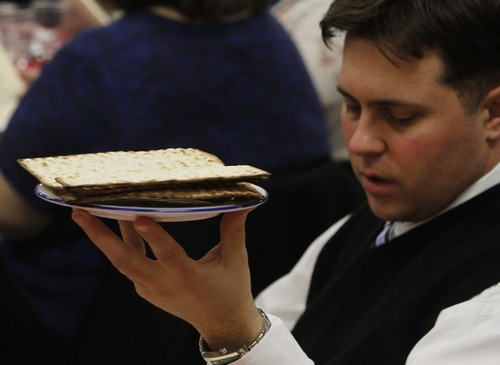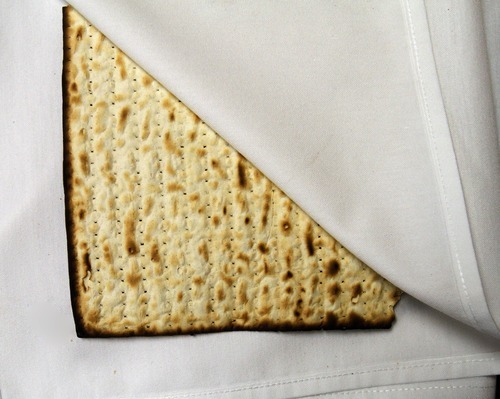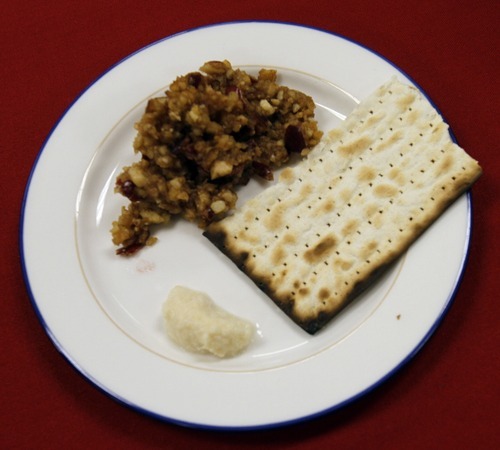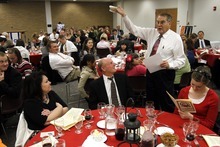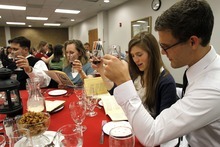This is an archived article that was published on sltrib.com in 2011, and information in the article may be outdated. It is provided only for personal research purposes and may not be reprinted.
Provo • Growing up in California, Korey Stevens had several Jewish friends who invited him to bar mitzvahs and Hanukkah celebrations.
But it wasn't until Stevens moved to Provo to attend Brigham Young University that he participated in a traditional Passover seder.
"I had heard my friends talk about it, but I didn't know what they did," said Stevens, who attended a Jewish seder service Saturday, April 8, at the Wilkinson Student Center on the Provo campus.
At sundown on Monday, April 18, Jews everywhere will celebrate the beginning of Passover with a ceremonial feast called a seder. Before the traditional lamb or beef brisket is served, they will spend time retelling the centuries-old story of when the Israelites escaped Egyptian slavery.
Most people know the story from the biblical book of Exodus. Moses demands that Pharaoh release his people. The king refuses. In turn, God sends 10 plagues against the Egyptians until finally, the Pharaoh relents. As the Israelites flee, Pharaoh sends his army after them. The Israelites are forced to the shore of the Red Sea and seem fatally trapped, until the waters miraculously part and Moses leads his people safely to the other side.
During the seder, which means "order" in Hebrew, there are 14 steps that are followed, and certain foods are used as symbols to help faithful Jews remember the story.
While seders are usually performed in homes for close family, it's a popular custom to invite people who aren't Jewish to the meal. Nationally, there's a trend to make seder services more inclusive. In recent years, new haggadahs — booklets that everyone follows so the blessings, narrative and songs are performed in correct order— have become available that reflect different seder approaches. There are versions for traditionalists and liberals, vegetarians and vegans — even recovering alcoholics.
BYU seders pre-date many of these newer versions. Professor Victor Ludlow, a specialist in Jewish studies at BYU, first offered a seder service in 1973 for his students and their family and friends to give them a deeper sense of its history and meaning. Each year, the service — conducted with a decidedly Mormon flavor — expanded. Eventually, the service was opened up to the public.
This year, BYU is offering seven events, each one accommodating about 175 people. The events usually sell out. The last two meals are scheduled for April 15 and April 22.
"This experience enriches one's appreciation of the ancient Old Testament," said Ludlow, who is retiring from the BYU faculty this spring. He plans to continue offering the seder services in future years as a way to help Christians better understand the real story of Easter. "The Last Supper was a Passover seder meal," Ludlow said.
Before the seder meal — which at BYU translates to catered chicken and potatoes — guests must first eat dry unleavened bread called matzo and bitter horseradish. The bitter herb burns the eyes and nose and leaves many grasping for their water glasses.
"I went into it a little cocky," Stevens said about eating the horseradish, "I served a mission in Cambodia and was used to spicy dishes with ginger. I thought the horseradish looked similar and would taste the same."
Fortunately, there's also a sweet apple-and-nut relish — called haroset — as well as songs and the game of hiding the afikomen (a piece of matzoh) that make the meal an event for many families.
Not surprisingly, on the four occasions during the service when guests must drink "the fruit of the vine," the mostly Mormon group sips grape juice, not the traditional wine.
"I love the idea that it has been handed down for 3,000 years. That's almost incomprehensible," said Karen Winterfeldt. The Lehi woman has attended the BYU seder with her married children and grandchildren for the last three years. "Despite all they (the Jewish people) had been through they were able to preserve this tradition. It's such a faith builder."
Because Ludlow explains Jewish history, the Passover steps and the symbols, the evening celebration stretches to nearly four hours. But most people don't mind.
"It's a good reminder of why we celebrate Easter," said Jenn Jones of Draper. "And it's a good way to connect with my own faith."
Foods of Passover
Unleavened bread (matzo) • When the Pharaoh allowed the Israelites to flee, they had to do it quickly, leaving little time to allow loaves of bread to rise.
Fruits and nuts (haroset) • A sweet relish made with finely chopped apples, nuts and spices. Its sweetness reminds Jews of freedom, but also symbolizes the building mortar the Hebrew slaves used to make bricks during their time of slavery and forced labor.
Green herb (karpas) • Most families use parsley to represent spring and the renewal of life. It's dipped in salt water, a symbol of the Israelite slaves' tears.
Bitter herbs (maror) • Usually raw horseradish, which is eaten to symbolize the bitterness of slavery.
Lamb (z'roa) » A roasted shank bone symbolizes the special sacrifice made on the eve of the exodus from Egypt.
Egg ( beitzah ) • A hardboiled egg represents the offering brought to the Holy Temple.
Wine » Four cups of wine are consumed at different points during a seder to commemorate the redemption of the Jewish people . —
Haroset (apple walnut relish)
2 tart unpeeled apples, grated or finely chopped
1/2 cup walnuts or almonds, finely chopped
1/4 cup raisins, optional
3 tablespoons honey, grape juice or wine
1/4 tablespoon cinnamon
Combine all the ingredients and serve.
Servings • 4
Source: Brigham Young University —
Matzah (unleavened
bread)
3 cups matzah meal
Pinch of salt
Water
Heat oven to 400 degrees. In a bowl, combine matzah meal and salt and add just enough water to form a dough. Knead until soft and fine. Divide into three parts, then roll each ball until 1/4-inch thick, similar to pie crust. Use a fork to lightly puncture the dough. Place dough on a cookie sheet that has been lightly greased with vegetable oil. Bake until lightly browned on top. Turn and bake until second side is brown. Remove from oven.
Servings • 3 sheets
Source: Brigham Young University


